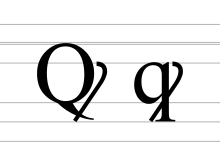Q with stroke


Q with stroke (Ꝗ, ꝗ) is a letter of the Latin alphabet, derived from writing the letter Q with the addition of a bar through the letter's descender. The letter was used by scribes during the Middle Ages, where it was employed primarily as an abbreviation[1]—a modern parallel of this would be abbreviating the word "and" with an ampersand (&). The letter was also used to write some modern languages. Between 1928 and 1938, the Lezgin and Dargin alphabets had used Ꝗ, but since 1938, both corresponding languages are written with Cyrillic-based alphabets, using the digraph Кь in place of Ꝗ.
When used to write the Latin language, ꝗ could be used alone or as part of a word. Alone, it stood for quam; as part of a word, it stood for either quan- (as in ꝗdo for quando) or qui- (as in ꝗlꝫ for quilibet).[1] In the French language, ꝗ was used as an abbreviation for the word que;[2] in Irish, it abbreviated ar.[1] Closely related is the letter Q with diagonal stroke (Ꝙ, ꝙ), which stood alone to abbreviate quod, qui and que in Latin.[1] In Portuguese, ꝙ also abbreviated quem.[1]

Computer encoding
[edit]Ꝗ and Ꝙ, along with other letters of interest to scholars of medieval manuscripts, was added to the Unicode Standard in 2006 after a request by Michael Everson.[1] It resides in the Latin Extended-D block of the Basic Multilingual Plane.
| Preview | Ꝗ | ꝗ | Ꝙ | ꝙ | ||||
|---|---|---|---|---|---|---|---|---|
| Unicode name | LATIN CAPITAL LETTER Q WITH STROKE THROUGH DESCENDER |
LATIN SMALL LETTER Q WITH STROKE THROUGH DESCENDER |
LATIN CAPITAL LETTER Q WITH DIAGONAL STROKE |
LATIN SMALL LETTER Q WITH DIAGONAL STROKE | ||||
| Encodings | decimal | hex | dec | hex | dec | hex | dec | hex |
| Unicode | 42838 | U+A756 | 42839 | U+A757 | 42840 | U+A758 | 42841 | U+A759 |
| UTF-8 | 234 157 150 | EA 9D 96 | 234 157 151 | EA 9D 97 | 234 157 152 | EA 9D 98 | 234 157 153 | EA 9D 99 |
| Numeric character reference | Ꝗ |
Ꝗ |
ꝗ |
ꝗ |
Ꝙ |
Ꝙ |
ꝙ |
ꝙ |
| ISO 5426-2 | 104 | 68 | 120 | 78 | ||||
References
[edit]- ^ a b c d e f Everson, Michael; et al. (2006-01-30). "Proposal to add medievalist characters to the UCS" (PDF). The Unicode Consortium. Retrieved 2017-02-01.
- ^ du Bellay, Joachim (1549). "La Deffence, et illvstration de la langue francoyse". Wikisource (in French). Wikimedia Foundation. Retrieved 2017-02-01.
